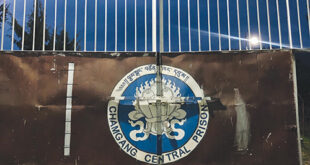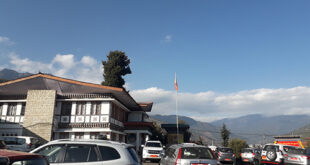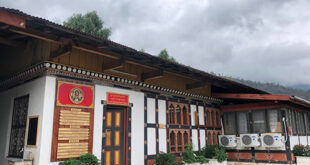
The question of Bhutanese officials endorsing Chinese claims of Bhutanese territory on the basis of an outline of a Chinese map in their passport does not arise at all, foreign minister in-charge Lyonpo Khandu Wangchuk told The Bhutanese yesterday.
“The total Chinese territory is over 9.6 mn sq km and the disputed area in the western sector is 269 sq km. Therefore, on the scale and size of the outlined map in the Chinese passports, it is not possible to say if the disputed area has been incorporated into Chinese territory,” Lyonpo Khandu said.
This statement comes as a response to a story published by this paper following a comprehensive research and comparison of Chinese and Bhutanese maps whereby it was found that a new Chinese passport displayed a map where 269 sq km of Bhutanese territory was shown as Chinese territory.
It also follows substantial coverage by the international media on controversial Chinese passport maps showing disputed territories with its neighbors like India, Vietnam, Taiwan, Brunei, Malaysia and Philippines being under China. The governments in all these countries protested and have started taking a variety of different remedial action from not stamping passports to giving different visas.
This paper had reported that Bhutanese Immigration and Visa officials, for the past few months have been unknowingly stamping official government seals on the new Chinese passports which show maps with parts of Bhutanese territory as being under China.
In this case the impasse for the involved countries is the stamping of these Chinese passports with official government seals could be seen as indirectly endorsing China’s new map.
China from the 1950’s started publishing official political maps showing the 269 sq km in Western Bhutan reflected as part of its own territory. It was this same map that was published in the passport and can be confirmed by closely examining the passport map and comparing it to a world map or Google earth map.
“Safeguarding Bhutan’s territorial integrity is the national priority of the Royal Government and it is one of the important foreign policy objectives. On the boundary between Bhutan and China, as we are all aware, the two governments are committed to resolving the boundary issue through dialogue on the basis of mutual understanding and accommodation,” Lyonpo Khandu said.
Millions of such new Chinese e-passports were issued in May 2012 and Bhutan in 2012 alone had 3,448 Chinese tourists visit as the third highest group after Japan and America. It is mandatory for Chinese tourists to have their passport and visa stamped by Bhutanese Visa and Immigration officials when they enter Bhutan.
“Pending the final settlement of the boundary, we are also aware that the two government s has agreed to maintain peace and tranquility on the border and to maintain status-quo on the border as before March 1959,” Lyonpo Khandu told The Bhutanese.
“Having said this, the article by The Bhutanese is therefore misleading and in many ways it can be construed as mischievous and does not represent the fact,” Lyonpo said.
The disputed areas are Bhutanese territory under Haa Dzongkhag and comprises four pasture areas of Doklam (89 sq km) and Giu, Sinchulumpa, Shakhateo and Dramana (180 sq km) coming to a total of 269 square km (see picture) all adjoining the Chumbi valley in China.
In the 20 boundary talks held till date between the two nations, Bhutan has upheld these areas as Bhutanese territory and is so reflected in maps issued by Bhutan. However, the Chinese representatives during the boundary talks laid claim to the 269 sq km on Bhutan’s Western Borders in addition to another 495 sq km area in Pasamlung, Bumthang which is also Bhutanese territory.
Lyonpo Khandu said “there is also agreement to refrain from taking any unilateral action to change the status- quo of the boundary. These agreements are reflected in the 1988 guiding principles for the settlement of the boundary and the 1998 agreement on maintenance of peace and tranquility in the border areas that you are all aware.”
He added that the agreements are strictly adhered to by the two governments. “We have both committed to adhering strictly to the agreement. Therefore, any unilateral action whether intended or implied to change the status-quo of the boundary issue will be in violation of this agreement,” he explained.
Bhutan and China have so far had 20 rounds of border talks with China since 1984 till 2012. The last was held earlier this year in the capital on August 10, led by Lyonpo Khandu Wangchuk and the Chinese vice Foreign Minister, Fu Ying, where both the countries reaffirmed their commitment to resolve boundary issue at the earliest, which was more or less a repetition of many such meetings between the two countries.
 The Bhutanese Leading the way.
The Bhutanese Leading the way.




Since The Bhutanese raised this story first, maybe if we can see picture of the new map in the Chinese passport, us readers can compare the map in the passport against the disputed border as shown on google map (as in the previous story).
so ‘tn’ you are the ignorant fool here huh. more than 3000 chinese tourists has entered bhutan in 2012 with the passports. google out their map if you want to have a closer look. i did it my self. china map is all over the net and every tom dick & harry knows it includes our disputed land in the west and southwest. dont instigate and try to make The Bhutanese blow up such sensitive issues by publishing maps. they have done their job by informing people about the latest Chinese move. be a responsible reader and a literate media consumer.
Yes,i am ignorant, but I think you miss the point.
I am aware of china’s maps with the borders as they claim. We also publish Bhutan maps with our claimed area like every other country with disputed borders. I have however never seen a Chinese passport or high resolution of the areas in debate.
My post is triggered by the acting Foreign Ministers remarks that scale of the map used in the passport does not allow us to make out any areas in dispute.
However the Bhutanese while publishing a headline story has also not shown the map from the passport but instead a screenshot from Google Maps, which happens to be scalable to a high resolution. They assume rightly that chinese official map was reproduced in small size
I just wanted to know if ‘The Bhutanese’ has indeed examined the new Chinese passports or high resolution images of said maps in said passport. Did they confirm if the map in the passport indeed show parts of Bhutan visibly claimed by China? and if they could show that part, instead of a Google map.
Unless the passport has high resolution printing of the map with all the small detail visible, no need to make an issue if the area in dispute is not visible, just to sell more newspapers.
you may want to ask the chair warmers in foreign ministry to ask ‘the bhutanese’ to show you a high resolution map.
Still missing the point.
This is an important issue and we need to look at it carefully, but that is beside the point of my question.
I’m not a writer so maybe its may fault as well for not being so clear.
My question was aimed reporting methods and basis for this story by “The Bhutanese” (the newspaper). This is a question also about media quality in general of the Bhutanese media (not the paper, the whole fraternity). Since we started down this path of democracy, we need a strong media as part of the acountability for the powers given to our elected leaders. But that means doing good journalism with fact checks, absence of bias and not for sensationalism based on assumptions or lack of fact checking.
Other stories on this issue from other countries show photos of the passport with areas in question highlighted such as the islands in the South China Sea, Arunachal Pradesh, etc. Those are clear to see. These stories also do not show a Google map – they show the maps in the passport.
national interest is important
U know Chinese has invaded our land from north n western part of HA Dzongkhag. You can see this from Google Earth map that they have build road bridges n houses. The settlements has also increase over past few months. The roads are building under the nose of our Army n Indian Army posted in Damthang, Ha.
Dear Sir,
I appreciate the topical and conversational value of the report in the Bhutanese on the inclusion of an outline of a controversial boundary outline in the new Chinese passports as Bhutan had yet to settle its boundary with China. Certainly this is an issue on which we cannot compromise for it concerns our sovereignty. Despite our differing profession we are all Bhutanese and it is the duty of each of us to defend our sovereignty , but I think we need to do it properly so that we have the desired outcome. It is in that context that we need to ask ourselves whether the sovereignty of the nation is being protected better by reporting in the media and making a big noise about it or would it have been better for the reporter to have brought this ‘negligence’ to the notice of the relevant authorities in the government. Obviously if the government did not take any steps after being informed, it would be a different matter and public pressure wold have been useful rectification tool.
Sadly such well meaning news reports plays into the hands of those who may want to create division and disharmony among friends and neighbours. I sincerely hope that such public conduct of diplomacy will not lead to loss of tourism income and create further intransigence in resolving the boundary between the two countries.
Nima et al.
This is a sour lesson for us and may be an expensive one which might complicate the boundary talks. The Chinese have done that with a purpose and we have not been able to smell the rat for so long. We cannot afford to make such blunders, especially when a longstanding border dispute is pending with China . Thats what happens when there is no system of taking accountability in the government and we shoot the messenger for the bad message.